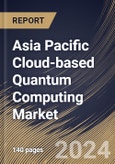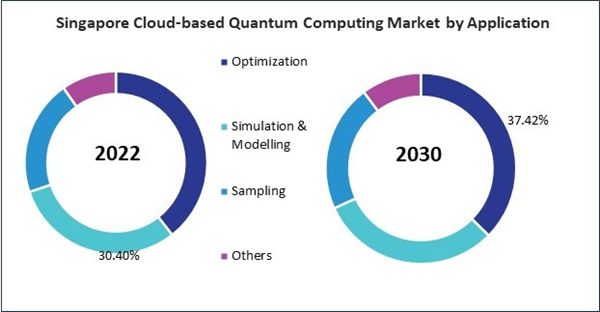The China market dominated the Asia Pacific Cloud-based Quantum Computing Market by Country in 2022, and would continue to be a dominant market till 2030; thereby, achieving a market value of $134.4 million by 2030. The Japan market is registering a CAGR of 20.1% during (2023 - 2030). Additionally, the India market would showcase a CAGR of 21.6% during (2023 - 2030).
The intersection of quantum computing and machine learning has given rise to the field of Quantum Machine Learning (QML). Cloud-based computing platforms facilitate the exploration of quantum algorithms for machine learning tasks, promising exponential speedup in certain applications. Algorithms like the Quantum Support Vector Machine (QSVM) and Variational Quantum Eigensolver (VQE) hold the potential for enhancing machine learning capabilities.
Moreover, quantum computing's impact extends to cybersecurity through quantum cryptography. These platforms enable the exploration of quantum-safe cryptographic methods that leverage the principles of quantum mechanics to secure communication channels. For instance, Quantum Key Distribution (QKD) protocols offer a quantum-resistant approach to secure data transmission.
India's BFSI sector has witnessed exponential growth, driven by economic development, technological advancements, and increased financial inclusion. As per the Indian Brand Equity Foundation, by 2025, the Indian fintech sector is anticipated to be worth $150 billion. India possesses the third most extensive fintech ecosystem. India is among the fintech sectors with the most rapid expansion. There are over 2,000 DPIIT-recognized Financial Technology (FinTech) businesses in India, and the number is rapidly increasing. Hence, the rising BFSI and automotive sectors in Asia Pacific can drive the growth of the regional this market.
Based on Solution, the market is segmented into Software, and Services. Based on Technology, the market is segmented into Superconducting Qubits, Trapped Ions, Quantum Annealing, and Others. Based on Application, the market is segmented into Optimization, Simulation & Modelling, Sampling, and Others. Based on Vertical, the market is segmented into BFSI, Healthcare, Automotive, Energy & Power, Aerospace & Defense, Government, Chemical, and Others. Based on countries, the market is segmented into China, Japan, India, South Korea, Singapore, Malaysia, and Rest of Asia Pacific.
List of Key Companies Profiled
- Google LLC (Alphabet Inc.)
- Microsoft Corporation
- IBM Corporation
- Amazon Web Services, Inc. (Amazon.com, Inc.)
- Baidu, Inc.
- Huawei Technologies Co., Ltd. (Huawei Investment & Holding Co., Ltd.)
- Terra Quantum AG
- SpinQ Technology Co., Ltd.
- QpiCloud Techonologies
- CERN
Market Report Segmentation
By Solution- Software
- Services
- Superconducting Qubits
- Trapped Ions
- Quantum Annealing
- Others
- Optimization
- Simulation & Modelling
- Sampling
- Others
- BFSI
- Healthcare
- Automotive
- Energy & Power
- Aerospace & Defense
- Government
- Chemical
- Others
- China
- Japan
- India
- South Korea
- Singapore
- Malaysia
- Rest of Asia Pacific
Table of Contents
Companies Mentioned
- Google LLC (Alphabet Inc.)
- Microsoft Corporation
- IBM Corporation
- Amazon Web Services, Inc. (Amazon.com, Inc.)
- Baidu, Inc.
- Huawei Technologies Co., Ltd. (Huawei Investment & Holding Co., Ltd.)
- Terra Quantum AG
- SpinQ Technology Co., Ltd.
- QpiCloud Techonologies
- CERN
Methodology

LOADING...









